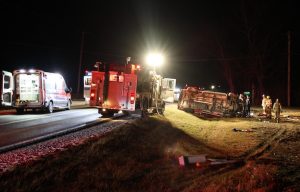School busing revisited
School districts in Monroe County continue to face transportation challenges as, like districts across the country, they face a shortage of bus drivers.
An Aug. 15 article by Mark Lieberman of Education Week titled “Schools Don’t Have Enough Bus Drivers to Start the School Year–Again” provides a national perspective on the issue.
The article specifically points to Orange County, Fla., as its busing figures have dropped from 70,000 students and 800 buses prior to the COVID-19 pandemic to 53,000 riders and 500 buses at the start of this school year.
Also noted are the Columbus, Ohio, district which is “down nearly a quarter of the 610 drivers needed for the start of the school year,” the Paradise Valley, Ariz., district which has less than half of the 110 required drivers and statewide school system in Hawaii which has lost dozens of routes with the lack of drivers.
Consequences of this shortage include districts increasing their pay or benefits and districts contracting to outside busing or transportation services.
Again focusing on Orange County, the article notes how many buses there have begun making two trips in the morning and afternoon, with staffers being asked to “arrive at work earlier to greet students when they arrive or leave work later to wait for the last ones to leave.”
The article further describes how not every district has been faced with a harsh shortage. Schools in Baltimore County, Md., have actually had to turn away applicants while schools in nearby Harford County, Md., find themselves lacking three drivers for their 24 buses.
Schools in Monroe County seem to fall somewhere in the middle as they feel a shortage of drivers, though it’s not quite as crippling as in districts elsewhere.
An article in the Sept. 25 edition of the Republic-Times focused on issues the Waterloo School District has faced.
As noted in that article, many drivers in the district feel very passionate and enthusiastic about their work, noting many benefits from the general improvements to driving they’ve noticed with their experience behind the wheel of a bus to the satisfaction and cheer they experience helping kids begin and end their school days.
Still, the district’s bus service, Illinois Central School Bus, has been actively trying to recruit new drivers to fill existing gaps as driver numbers have stagnated seemingly due to some of the more stressful parts of the job – handling a rather large vehicle and keeping track of students – as well as some potential conflicts with management.
In Columbia, Abby Mueller, who serves as co-director for the school district’s transportation department, spoke fairly positively about the current situation, explaining that her district is doing substantially better compared to last year.
Per Mueller, Columbia’s buses are fully staffed and are even prepared with substitutes when needed.
“I think that’s where we saved ourselves at is having that extra person that is able to handle those absences we might have,” Mueller said. “This year is definitely a lot better than last. People are more interested in driving.”
Mueller, who started with the district in 2021, explained that her focus these past few years has been on driver retention, providing the office amenities and generally striving to make sure drivers feel welcome.
She also spoke about the pay scale for drivers. Those who come in with training start at $28.45 an hour, with every driver after two years of service going up to $32.98. Untrained drivers are also welcome, though starting pay does go down to $21.13.
Regarding the cause of the driver shortage, Mueller said the pandemic certainly didn’t help bring in or keep drivers, with a number of older drivers hesitant to get out since the pandemic began.
She also noted, however, that the small-town atmosphere seems to have helped fill driver’s seats as folks have become aware of the shortage.
Going forward, she’s looking to make sure the district isn’t left short of drivers again as those older members on staff look toward retirement.
“I’m definitely looking to bring some younger folks on,” Mueller said. “The folks that we have here are getting older, and I know that they’re going to be looking at retiring, so I’m really just trying to show younger people… I’m only 30 myself. Even if it’s not your full-time career, it can definitely be a stepping stone.”
Columbia Superintendent of Schools Chris Grode also spoke about Columbia’s handling of the driver shortage, noting that Mueller herself is sometimes among those who step in to drive the district’s buses.
He suggested that the district is making do at this point, adding that drivers have always been difficult to find given it is a part-time job with rather awkward hours that doesn’t seem to cater to many.
“A lot of times, farmers will be bus drivers,” Grode said. “You try to find someone who has a CDL, can handle big equipment and has the flexibility. You’ve got people that are retired or people that it just happens they don’t need a full-time job.”
Grode also emphasized the importance of drivers in a district, not only for the fundamental need of transporting students but also for the impact they can have on those students.
“The first person the child sees from the district is the bus driver,” Grode said. “That can set the tone for the entire day for that child… They’ve got an incredibly important job.”
Valmeyer Superintendent of Schools Eric Frankford also offered some perspective on how his district is faring, suggesting this year doesn’t seem to be exceptional with regards to needing new drivers.
He noted that new bus drivers have always been welcome and looked for, particularly since the pandemic began.
“I don’t know if this year is any different, but especially since the pandemic, the number of people willing to drive a school bus is definitely not as much as it was, say, 15-20 years ago,” Frankford said.






